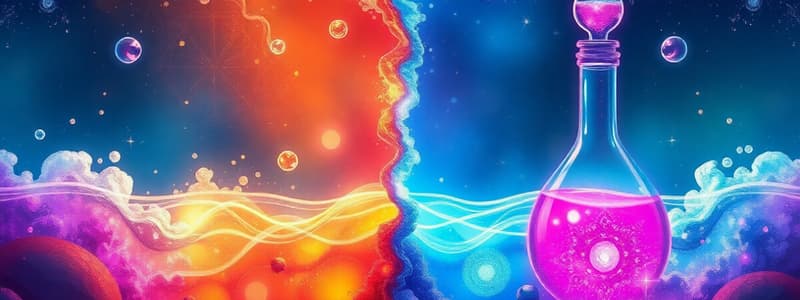Podcast
Questions and Answers
What characterizes a reversible change?
What characterizes a reversible change?
- New material is formed during the change.
- The original form of the object can be restored. (correct)
- The change affects the chemical composition of the object.
- The object's change is always temporary.
Which of the following is an example of an irreversible change?
Which of the following is an example of an irreversible change?
- Melting ice into water.
- Freezing juice into ice pops.
- Frying an egg into an omelette. (correct)
- Boiling water to steam.
Which statement is true regarding irreversible changes?
Which statement is true regarding irreversible changes?
- They do not alter the original object's appearance.
- They result in the formation of new materials. (correct)
- They can often be reversed by physical means.
- They are always temporary in nature.
What happens to the physical appearance of an object in a reversible change?
What happens to the physical appearance of an object in a reversible change?
Which of the following best describes irreversible changes?
Which of the following best describes irreversible changes?
Flashcards
Reversible Change
Reversible Change
A change where the original object can be recovered.
Irreversible Change
Irreversible Change
A change where the original object cannot be recovered.
Physical Change
Physical Change
A change in appearance but not in the object's makeup.
Composition
Composition
Signup and view all the flashcards
Permanent Change
Permanent Change
Signup and view all the flashcards
Study Notes
Reversible Changes
- A change is reversible if the object can return to its original form.
- No new material is created in a reversible change.
- The object's appearance changes, but its composition does not.
Irreversible Changes
- A change is irreversible if the object cannot return to its original form.
- A new material is usually formed in an irreversible change.
- Irreversible changes are permanent.
Solutions
- A solution forms when two or more substances mix evenly.
- The substance dissolving is the solute.
- The substance the solute dissolves in is the solvent.
- Water is a universal solvent.
- Solute + Solvent = Solution (e.g., salt + water = salt water)
Mixtures
- A mixture is a combination of two or more substances without a chemical reaction.
- Mixtures can be separated by various methods like sieving, hand-picking.
Filtration
- Filtration separates mixtures of liquids and insoluble substances.
- Insoluble substances remain on the filter paper.
- The liquid passes through the filter paper and collects below.
- Examples include separating tea leaves from tea.
Evaporation
- Evaporation is used to separate a solid from a liquid in a solution.
- The liquid evaporates, leaving the solid behind.
- When two liquids completely dissolve in each other, they are called miscible liquids.
- Otherwise, they are called immiscible liquids.
Layers of the Earth
- Earth has layers: crust, mantle, core.
- Crust is the outermost hard layer, mostly covered by water, soil, sand and ice.
- Mantle is the layer beneath the crust, comprising around 80% of the Earth.
- Core has an inner (solid) and outer (molten) part, primarily composed of iron and nickel.
Igneous Rocks
- Igneous rocks form from cooled magma (molten rock).
- Magma can cool inside or outside the Earth.
- Common igneous rocks include granite, pumice, basalt, and obsidian.
- Granite is used in buildings, basalt in roads, pumice as a cleaning agent.
Sedimentary Rocks
- Sedimentary rocks form from the accumulation and cementing of sediments (rock fragments).
- Examples include limestone, conglomerate, sandstone, and shale.
- Limestone is used in construction and making lime.
- Sandstone is used in construction.
Metamorphic Rocks
- Metamorphic rocks form when igneous or sedimentary rocks change due to heat and pressure.
- Examples include slate, marble, schist, and quartzite.
- Slate is used for roofing and in gardens.
- Marble is used for buildings and sculptures.
Minerals
- Minerals are naturally occurring substances with a specific chemical composition and crystal structure.
- Some minerals have important uses in our daily lives, including construction, manufacturing, and jewellery.
- Examples include graphite (used in pencils), coal (fuel), gold (jewellery), silica (glass).
Studying That Suits You
Use AI to generate personalized quizzes and flashcards to suit your learning preferences.
Related Documents
Description
This quiz explores the concepts of reversible and irreversible changes, solutions, and mixtures. Test your understanding of how substances interact and the methods used to separate mixtures. Dive into the fascinating world of chemistry and distinguish between different types of changes and solutions.




